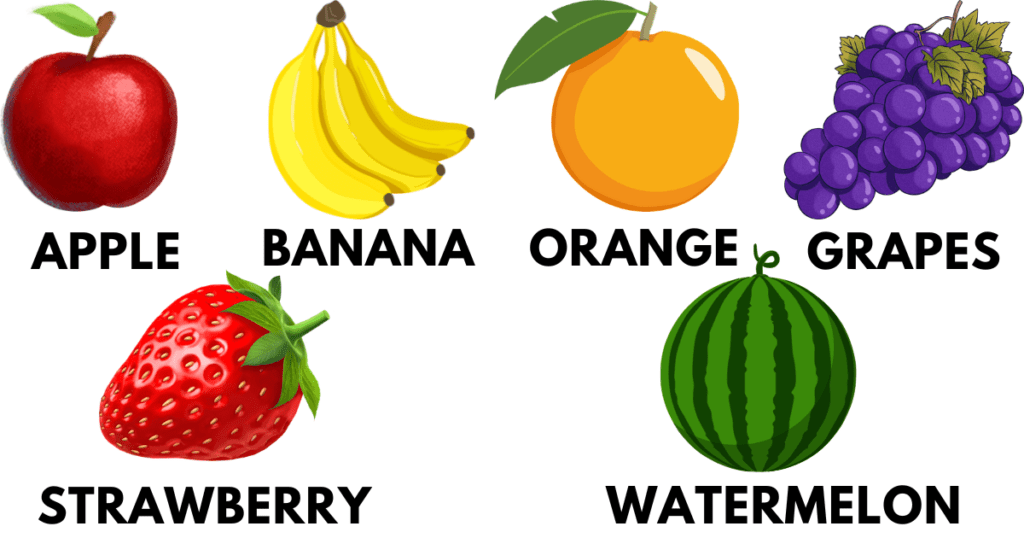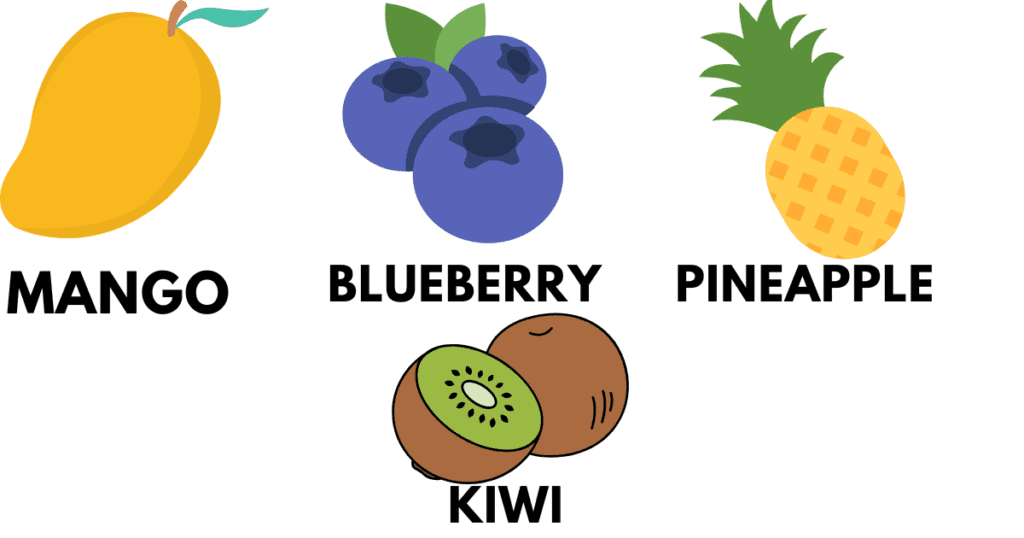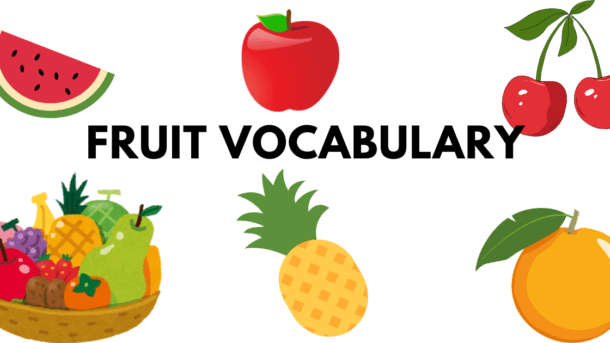In this Fruit vocabulary lesson, we will explore an extensive range of fruit vocabulary that will not only help you name different fruits but also allow you to describe them and express your preferences.
Grammatically, do you say Fruit or Fruits?
The term “fruit” can be used both as a singular and plural noun, so you can say either “fruit” or “fruits.” “Fruit” is commonly used when referring to the general category or collective group (e.g., “I love fruit”), while “fruits” is used when talking about different varieties or types (e.g., “I bought several fruits from the market”).
Why Learn Fruit Vocabulary?
Fruits are a universal part of our diets and cultures. Learning fruit vocabulary can open up conversations about healthy eating, cooking, and cultures around the world. Furthermore, fruits are often involved in social activities, making this fruit vocabulary practically useful. Whether you want to order a smoothie at a café, discuss dietary habits, or simply share your favorite fruits with friends, you’ll find that knowing this vocabulary makes a significant difference.
Essential Fruit Vocabulary


Here’s a list of some common fruit vocabulary along with a brief description and examples.
1. Apple
Description: Apples are round fruits that come in various colors, including red, green, and yellow. They are crisp and juicy.
Example Sentence: An apple a day keeps the doctor away.
2. Banana
Description: Bananas are long, yellow fruits that are sweet and soft. They are easy to peel and eat.
Example Sentence: I love eating a banana for breakfast.
3. Orange
Description: Oranges are round, juicy citrus fruits with a sweet and tangy flavor. They have a thick, orange peel.
Example Sentence: I like to drink orange juice in the morning.
4. Grapes
Description: Grapes are small, round fruits that can be green, red, or purple. They grow in bunches and are typically sweet.
Example Sentence: I enjoy snacking on grapes while watching TV.
5. Strawberry
Description: Strawberries are small, red fruits with tiny seeds on the surface. They are sweet and juicy and often enjoyed in desserts.
Example Sentence: Strawberries are my favorite fruit for making smoothies.
6. Watermelon
Description: Watermelons are large, green fruits with a thick rind and sweet, red pulp filled with seeds. They are very refreshing.
Example Sentence: Eating watermelon is a perfect way to cool down on a hot day.
7. Pineapple
Description: Pineapples are tropical fruits with a rough, spiky exterior and sweet, juicy flesh inside.
Example Sentence: Pineapples are delicious in fruit salads.
8. Blueberry
Description: Blueberries are small, round berries that are typically blue or purple. They are sweet and often added to cereal or yogurt.
Example Sentence: Blueberries are rich in antioxidants and very healthy.
9. Mango
Description: Mangoes are tropical fruits that have sweet, juicy flesh and a large pit in the center. They can vary in color from green to yellow to red.
Example Sentence: I love adding mango to my fruit salad.
10. Kiwi
Description: Kiwis are small, brown fruits with fuzzy skin and bright green flesh inside. They have a unique sweet-tart flavor.
Example Sentence: Kiwis are not only tasty but also packed with vitamins.
Types of Fruit
Let’s start with some common types of fruit. Here are some popular examples:
- Citrus Fruits:
- Orange: Sweet and juicy, great for juicing.
- Lemon: Sour and tangy, often used to add flavor.
- Lime: Similar to a lemon, used in drinks and dishes.
- Berries:
- Strawberry: Bright red and sweet, excellent in desserts.
- Blueberry: Small, round, and sweet with a hint of tartness.
- Raspberry: Juicy and a bit tart, great for jams.
- Stone Fruits:
- Peach: Soft and sweet with a fuzzy skin.
- Cherry: Small and round, can be sweet or tart.
- Plum: Juicy and sweet, often used in desserts.
- Tropical Fruits:
- Mango: Sweet and tropical, often eaten fresh or in smoothies.
- Pineapple: Sweet and tangy, great on its own or in dishes.
- Banana: Soft and sweet, a popular snack.
Descriptive Adjectives for Fruit
To enhance your vocabulary, it’s important to learn adjectives that describe fruits. This will allow you to not only name fruits but also talk about their characteristics. Here are some key adjectives:
1. Sweet: Tasting like sugar.
- Example: “The mango is very sweet.”
2. Sour: Having a sharp taste, acidic.
- Example: “Lemons are quite sour.”
3. Juicy: Full of juice.
- Example: “Watermelons are juicy and refreshing.”
4. Ripe: Ready to eat, fully matured.
- Example: “Make sure to pick ripe bananas for your smoothies.”
5. Fresh: Recently picked or made.
- Example: “I like to eat fresh strawberries.”
6. Fleshy: Thick or juicy part of the fruit.
- Example: peaches have fleshy skins
7. Soft: refers to fruits that have a tender, delicate texture and are typically juicy.
- Example: “Overripe fruit can be very soft.”
8. Crunchy: Making a sound when bitten into, usually firm.
- Example: “An apple is crunchy when it’s fresh.”
9. Fragrant: refers to a pleasant or sweet smell
- Example: “Pineapples are fragrant when they’re ripe.”
10. Colorful: refers to vibrant colors or varied hues
- Example: “A fruit salad should be colorful and appealing.”
Useful Phrases for Discussing Fruit fruit vocabulary
To help you communicate effectively about fruits, here are some phrases you can use:
- “What’s your favorite fruit?”
- “How do you like to eat that fruit?”
- “Do you prefer [fruit A] or [fruit B]?”
- “I usually eat [fruit] in the morning.”
- “I prefer sweet fruits like mangoes.” – Sharing personal preferences.
- “That fruit is great for smoothies!”
- “Have you ever tried [fruit]?”
- “Can you recommend a good recipe using [fruit]?”
Fruits that people think are Vegetables:
Many fruits are commonly mistaken for vegetables due to their culinary uses. These include tomatoes, cucumbers, bell peppers, zucchini, eggplants, pumpkins, avocados, and squash. Despite being botanically classified as fruits, they are often prepared and served as vegetables in savory dishes.
Methods of Consuming Fruit
Fruits can be enjoyed in various ways, making them a versatile food choice. Here are some common methods of consumption:
- Raw: Eating fruits as they are, such as apples or bananas.
- Sliced: Cutting fruits into pieces, like sliced oranges or kiwi.
- Juiced: Extracting juice from fruits, such as orange juice or watermelon juice.
- Dried: Consuming fruits after they’ve been dehydrated, like raisins or dried figs.
- Cooked/Baked: Using fruits in recipes, such as apple pie or banana bread.
- In Salads: Adding fruits to salads for extra flavor and nutrition, like a fruit salad or adding sliced strawberries to a green salad.
30 different Fruit vocabulary in English
- Apple
- Banana
- Orange
- Grape
- Strawberry
- Pineapple
- Watermelon
- Mango
- Peach
- Cherry
- Lemon
- Lime
- Blueberry
- Raspberry
- Kiwi
- Pear
- Plum
- Apricot
- Coconut
- Pomegranate
- Fig
- Cantaloupe
- Papaya
- Tangerine
- Nectarine
- Cranberry
- Persimmon
- Guava
- Dragon fruit
- Starfruit
Tips For Studying Fruit Vocabulary In English
- Categorize: Group fruits into categories (e.g., tropical, berries, citrus) to make learning easier.
- Flashcards: Create flashcards with images and names of each fruit vocabulary for visual learning.
- Make Sentences: Write simple sentences using each fruit vocabulary to understand context and structure.
- Label: Place labels on real fruits at home to reinforce fruit vocabulary in a daily context.
- Use Apps: Utilize language learning apps that focus on vocabulary building and provide interactive quizzes.
- Practice Conversations: Incorporate fruit vocabulary into everyday conversations to increase familiarity.
- Watch Videos: Find videos or cooking shows highlighting fruit vocabulary for auditory and visual reinforcement.
- Review Regularly: Schedule periodic reviews of what you’ve learned to boost retention.
- Engage with Others: Study with friends or join study groups to make learning more interactive and enjoyable.
Fruit Vocabulary: Conclusion
Mastering fruit vocabulary is an enjoyable and practical way to enhance your English language skills. By knowing how to name, describe, and discuss fruits, you can engage in conversations about healthy eating, cooking, and cultural traditions.




